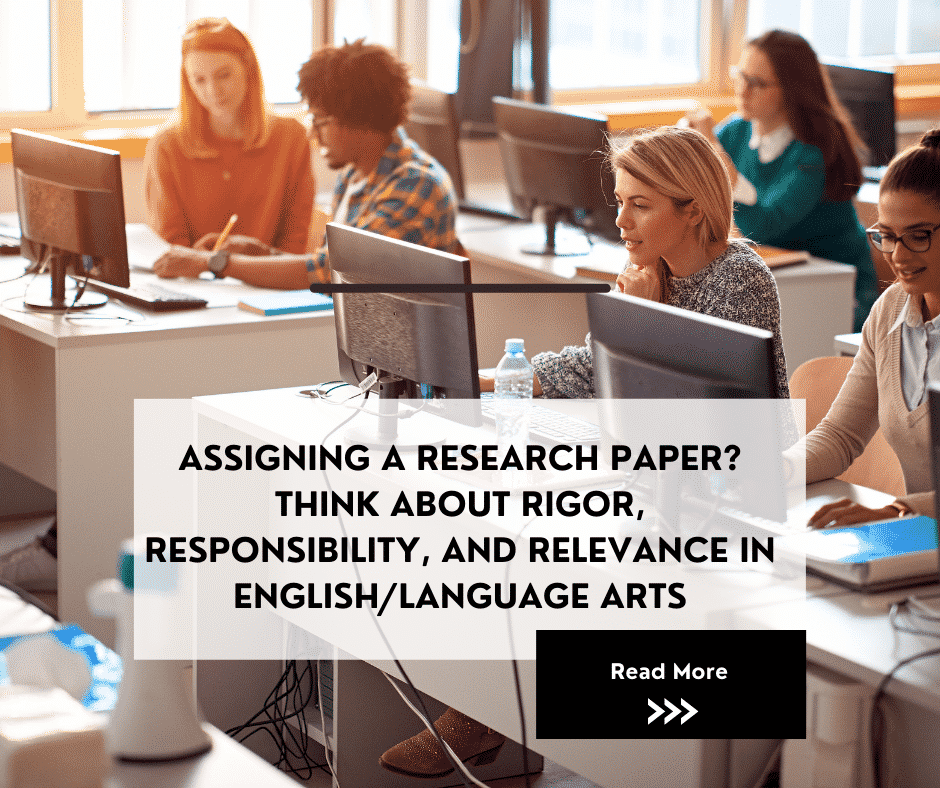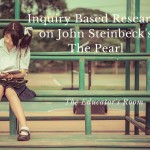As English language arts teachers, we need to teach the language of doing business along with the literary arts.
Thesis
We teach literary research and other standard ELA concepts because students will be able to transfer the skills. Simply put, if students can research the imagery of Emily Dickinson’s poems, they can, likewise, research blood-alcohol content as specialized lawyers in order to present cases. They can use their research skills and their experience with graphic organizers to determine whether their air conditioning repair businesses should specialize in fixing units or if it should expand to include the installation of new units. Well, that, and they learn culture from literary research…and characterization…and a plethora of literary skills along with a bolstered lexicon.
Furthermore, if students don’t learn to read critically, they will never know if they are being taken advantage of. If they don’t read, “Ain’t I a Woman?” they’ll never fully experience both the racism and sexism presented therein. If they don’t read “Harrison Bergeron,” they’ll never understand the dangers of ignoring sad things. If they don’t ever read Machiavelli, how will they be able to choose, even if arbitrarily, one of our major political parties and use what they read in The Prince to insult members of the other party?
Thesis: Research in English language arts should remain literary because the advantages are both cognitive and cultural. Without this research, we have lowered both our standards and our quality of living.
Antithesis
At some point in the mid-nineties, English language arts educators made the mistake of trying to prove that the transference of skills was not only possible but also easily adaptable to the timeless curriculum. In order to combine academia with industry, several initiatives were developed with the good intentions of proving how relevant the ELA curriculum could be in the real world. Initiatives like “School to Work” attempted to link all learning, including humanities, with occupational skills that, together, would create an enlightened and more skilled workforce.
Those were heady days where the hero’s journey in the Odyssey linked to computer coding and “A Modest Proposal” inspired students with an inclination for culinary arts. Then, someone took the practice to its most ridiculous extreme. The jazz age had its Black Friday. The sixties had its Altamont. American cycling had its Lance Armstrong. School to Work, similarly, had its Lady Macbeth memo.
For those of you who are, to your fortune, too young to remember, this was a now-legendary attempt to make Shakespeare relevant by linking his work with the contemporary practice of writing memos. As I recall, the idea was that Lady Macbeth would send a memo to her husband—an obviously natural audience for a memo—that revealed both her objectives and general characteristics. Since the motivations of classical characters can seem esoteric in the modern classroom, students pretended to be a wealthy woman writing a memo to her husband justifying the need for murder. You know, because who can’t relate to that, am I right?
Teachers were told that this lesson would become the beacon on the hill for other such relevant exercises. I remember listening to an excited educator at a state conference for English teachers sharing her proudest lesson with her peers. The lesson required students to write a formal block letter to their parents asking to borrow the car using the rhetorical strategies of Patrick Henry. Her thesis, as she mentioned several times, was that this lesson “hits all the specs of relevance.” By this, she meant that the lesson taught business writing skills, related to the student experience, and contained a literary component. When I introduced the lesson in my class, my students expressed an antithesis to this point: “This is stupid. Who writes a letter to their parents?”
Well, touché, students. The point is yours.
Today, I work for a company that helps students write college application essays. Some of them ask students to combine personal experience with their goals. Others ask students to write research papers that show that they can conduct research in the field in which they hope to earn a degree. I have helped a student explain how his experiences in a soup kitchen could help him become a caring and competent doctor. I helped another student explain how her internship with a state senator makes her a good candidate for an Ivy League school. I am currently helping two students explain why business ethics makes a company more marketable and makes business leaders more competent.
Interestingly, not one student has asked me to help with his/her essay on The Plague, Leaves of Grass, or Paradise Lost. Not one. Nor has any student come to me wanting help on any work of great literature akin to these examples. I’m using these examples because I focused on these works for research papers I wrote in high school. I learned a lot. I loved the process. I’m glad I have that experience.
Still, we sometimes realize that some ELA lessons teach students only if they want to become English teachers. That’s bad enough, but what I’m starting to realize is that the more theoretical knowledge doesn’t even help in that department. Most students reach the point that they’re writing about subjects totally unrelated to literature. In other words, we’re expecting students to transfer the ELA skills from literature to industry when the best we could do as an academic think tank was require the Lady Macbeth memo.
Do people even write memos anymore?
Antithesis: The teaching of research, critical reading, and writing processes should abandon outmoded literary treatises and focus on real-world skills that help students become competent and ethical leaders.
Synthesis
Under different circumstances, I might not have met the wonderful woman who is now my wife. I feel a similar shuddering sickness when I think that I might have gone through high school without reading and researching The Plague, Leaves of Grass, and Paradise Lost. Who would I even be now? Would I know nothing of existential yawping and pandemonium? Would I think only of the what and never question the why? Would I listen to a new country and eat Cheetos?
No one in ELA wants to get rid of literary research because without the philosophy and characterization we learn from these studies, life simply isn’t as full. As my senior English teacher often said, “This isn’t on the test. It will only improve the quality of your living.” No one wants to take away from that, but the proposal here is not either/or but both/and. We need to include both literary and real-world research; business research could be a large part of that real world. After all, doesn’t being a successful, independent person with marketable skills also improve the quality of your living?
The obvious objection that springs immediately is that we will run out of time. Expanding our focus doesn’t expand the time we have to teach. Something has to be sacrificed, and as sure as that is true, the sacrifice needs not to be researched. What can we cut?
Cut the “cute angles.” These are the angles we take when we find a “fun” way for students to work cooperatively to learn something sustainable about literature. At any given moment somewhere in America, butcher paper hangs on ELA corridors. Often, they depict drawings of Hester Prynne drawn to resemble an ER nurse. You know it’s Hester Prynne because she wears a big A on her left side. To show that the students have learned characterization, several descriptive words are graffitied over Prynne’s long dress and maybe even across her forehead. These words prove that groups of students collaborated, thought critically about characterization, and settled on what words to fling at her drawn effigy like the mud that the Puritan children fling at the character in the narrative. Of course, the words scrawled on the drawing seem suspiciously similar to the nouns in the first two paragraphs about Hester Prynne at Study.com, but if tax dollars are going to be spent on Crayola Washable Markers, then by golly, we better use them. And if not, how will they know about the Puritans?
Yeah, we could probably stand to lose that. And what about those lessons where we teach students that a prepositional phrase acts as an adverb rather than as an adjective? Has an editor ever rejected a manuscript because it contains too much of one and not enough of the other? Furthermore, what actually is a visual essay?
Cute? Yes. Useful? Well….
Instead, can we look to our standards for guidance? About twenty percent of our standards fall under the “Reading Informational” domain. This provides a great opportunity for students to find out what “Corporate Social Responsibility” really means and why the practice provides ways for companies and their products/services to be both marketable and socially aware. Let’s look at how Rachel Carson appealed to both logos and pathos when she explained that the pesticides being used were more harmful to humans as a species than to the insects we were trying to keep off our food. From that point, students, then, write their own problem-solution essays, solving real-world problems with ideas that they research. Certainly, this cuts out the time-honored and time-consuming multiple-choice tests, but many teachers who still crave such head-bashing futility can always write their principal a memo detailing how he or she could do a better job.
On the other hand, students and teachers can enjoy mutual learning.
- Did you and your students know that some outdoor clothing companies donate proceeds to both environmental and poverty-related causes while other companies only pretend to?
- Did either of you know that entire textbooks are published teaching students how to conduct research on corporate social responsibility?
- Did you know that at least two major car companies are known for making local rivers in the United States cleaner after their factories started running?
- Do your students know how to determine if employment in their chosen careers will increase or decrease over the next decade?
- How much better would our world be if we taught students to research issues like these?
- How much more educated would they be as both producers and consumers?
- What if they not only knew that the Puritans had a debilitating fear of progress (thesis) but that they also had an inspiring work ethic with highly evolved farming methods (antithesis) and that students could form their own opinions by looking at both their successes and failures (synthesis)?
Synthesis: Rather than hitting the specs, we should consider our goals. Students should conduct both literary and occupational research because, while cuts have to be made, we should not sacrifice rigor, relevance, and responsibility.
Getting Started
The trick to making research successful is to allow students the freedom to choose and personalize topics while forcing them to narrow the project’s scope. Students often want to begin by researching, for example, corporate social responsibility (CSR) as a topic itself. That may be a good place to begin, but the worst scenario is starting a project that either cannot be finished or one that has to be rushed and becomes surface-level at best.
Instead, make sure that students complete some preliminary research first so that they understand the terms and issues. If not, they get too far into the project and find that they have ignored either the most vital or the most modern issues.
Then, students have to form a tight, answerable research question. Yes, it has to be a question. Students will say, “I know what I want to look up, but I can’t form a question yet. I’ll just start writing and….” This project will never get finished. Students end up with a lot of writing that will ultimately have to be replaced.
Look at the differences among these questions:
(A) What companies include CSR as part of their business models?
(B) How does Patagonia use sustainability as an integrated part of the company’s marketing scheme?
(C) What leadership competencies does a social enterprise leader need in order to manage a successful and respectable company?
I am currently working with two students who started their projects with questions that looked like choice A. Not being a business-oriented person myself, I didn’t realize how far off the rails we would get and how much time we would waste with this broad question. I blame myself for that waste. I finally realized that the questions needed to be tight in that they have to use specific language or we will have a research field rather than a research project.
Keep this in mind: If you later realize that your student’s topic is too narrow, the student will be able to add to the topic and research ideas quickly. Narrowing a topic once a student starts writing can be almost heartbreaking because the student has made some efforts that will be totally wasted.
After forming a tight, answerable question, the student needs to write at least three drafts of a thesis before he or she ever starts synthesizing the main sources and certainly before the writing begins. The thesis needs specific language and active verbs. While this may be true of literary research, it’s even more true of business and other real-world research because, without precise clarity, you and your students can quickly get to the point that neither of you will understand what either of you is talking about or trying to prove. No matter how good the first draft of the thesis seems to be, find more specific ideas and words. Find more active and vivid verbs. Use more qualifiers to make sure that the topic is clear. Like a business, your research project needs a clear vision statement in the form of a thesis.
Finally, once the writing process begins, an often-overlooked element of student writing has to be checked at every opportunity: the concluding sentences of each body paragraph. Think of your paragraph like trying to build something and keeping it square. Once one corner or measurement is off, the rest of the measurements will be thrown off even more until, finally, nothing works. At the end of every paragraph, students should habitually review their brilliant thesis statements. Like magic, they will usually tie the concluding sentences to the thesis and keep their work on topic. If they don’t, two or three paragraphs later, they have gone off on a tangent and have brilliantly useless writing that doesn’t relate to the thesis.
- Complete some general preliminary research to understand both the major terms and the critical issues.
- Form a tight, answerable research question.
- Answer the question with a specific, active thesis.
- Stay on topic by constantly checking the concluding sentences.
While all of these points are helpful in any research, real-world research, like real-world work, can become unrecognizable and disorganized without a plan. Help students form that plan, and take pride in the fact that you have helped them become real-world leaders.






